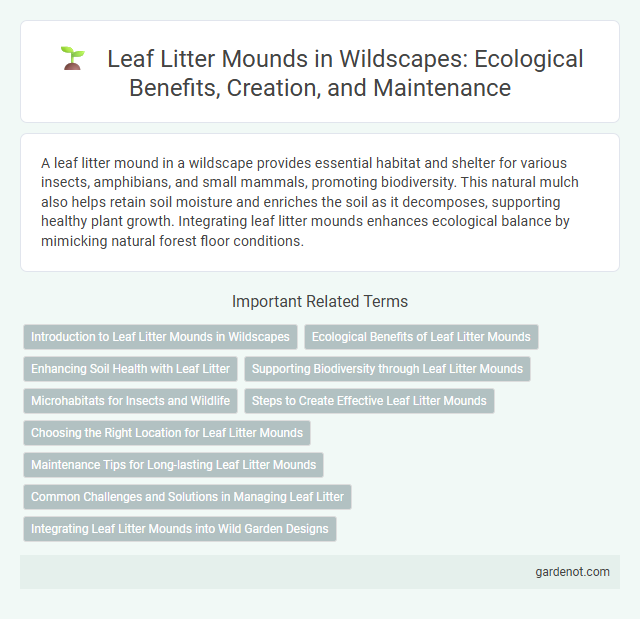A leaf litter mound in a wildscape provides essential habitat and shelter for various insects, amphibians, and small mammals, promoting biodiversity. This natural mulch also helps retain soil moisture and enriches the soil as it decomposes, supporting healthy plant growth. Integrating leaf litter mounds enhances ecological balance by mimicking natural forest floor conditions.
Introduction to Leaf Litter Mounds in Wildscapes
Leaf litter mounds play a crucial role in wildscapes by providing habitat and nourishment for diverse fauna such as insects, amphibians, and small mammals. These natural accumulations of organic debris contribute significantly to soil health by enhancing nutrient cycling and moisture retention. Incorporating leaf litter mounds into wildscape design fosters biodiversity and supports ecosystem resilience.
Ecological Benefits of Leaf Litter Mounds
Leaf litter mounds create essential microhabitats that enhance biodiversity by providing shelter and food sources for insects, fungi, and small mammals. These mounds improve soil health through organic matter decomposition, increasing nutrient cycling and moisture retention. Their presence supports ecosystem resilience by fostering habitat complexity and promoting natural pest control.
Enhancing Soil Health with Leaf Litter
Leaf litter mounds contribute significantly to enhancing soil health by promoting nutrient cycling and moisture retention within the ecosystem. The decomposing organic matter enriches the soil with essential nutrients such as nitrogen, phosphorus, and potassium, fostering robust plant growth and microbial activity. This natural process improves soil structure and supports biodiversity, making leaf litter mounds vital components of sustainable wildscape management.
Supporting Biodiversity through Leaf Litter Mounds
Leaf litter mounds play a crucial role in supporting biodiversity by providing essential habitats for decomposers such as fungi, insects, and microorganisms. These mounds facilitate nutrient cycling and soil health, promoting diverse plant growth and sustaining various animal species. Maintaining leaf litter layers enhances ecosystem resilience, fostering a balanced wildscape environment.
Microhabitats for Insects and Wildlife
Leaf litter mounds create essential microhabitats by providing shelter, moisture, and food sources for diverse insects and small wildlife. These mounds support decomposers like beetles, ants, and fungi that play a crucial role in nutrient cycling within wildscape ecosystems. Enhancing biodiversity, leaf litter mounds foster intricate ecological interactions critical for sustaining healthy habitats.
Steps to Create Effective Leaf Litter Mounds
Building effective leaf litter mounds involves selecting a shaded, moist location to ensure optimal decomposition and habitat conditions for wildlife. Layer fallen leaves with small twigs and organic debris to promote aeration and nutrient cycling, enhancing soil health. Regularly monitor moisture levels and replenish leaf material seasonally to maintain the mound's structure and ecological benefits.
Choosing the Right Location for Leaf Litter Mounds
Selecting the ideal location for leaf litter mounds involves prioritizing areas with ample shade and moisture to support decomposer organisms like fungi and invertebrates. Placing mounds near native plant species enhances nutrient cycling and promotes local biodiversity by providing habitat for amphibians and small mammals. Avoiding direct sunlight and excessive foot traffic ensures the mound retains moisture and remains undisturbed for optimal ecosystem functioning.
Maintenance Tips for Long-lasting Leaf Litter Mounds
Regularly monitor moisture levels in the leaf litter mound to prevent mold growth and maintain optimal decomposition conditions. Remove any compacted or overly decomposed material to ensure proper aeration and nutrient cycling within the mound. Incorporate fresh leaf litter periodically to sustain microbial activity and promote a healthy habitat for soil organisms.
Common Challenges and Solutions in Managing Leaf Litter
Leaf litter mounds in wildscapes often face challenges such as moisture retention issues, pest infestations, and nutrient imbalances that can hinder soil health and plant growth. Effective management solutions include regular monitoring of moisture levels, integrating natural predators to control pests, and periodically mixing leaf litter with organic compost to maintain nutrient diversity. Employing mulching techniques also helps stabilize temperature fluctuations and protects the microhabitat within the leaf litter mound.
Integrating Leaf Litter Mounds into Wild Garden Designs
Leaf litter mounds serve as essential microhabitats within wild garden designs, promoting biodiversity by providing shelter and nourishment for beneficial insects, amphibians, and soil organisms. Integrating these mounds enhances natural decomposition processes, improves soil fertility, and supports native plant growth by maintaining moisture and nutrient cycles. Strategically placing leaf litter mounds near shaded or damp areas maximizes ecological benefits and fosters a balanced, thriving wildscape ecosystem.
Leaf litter mound Infographic

 gardenot.com
gardenot.com